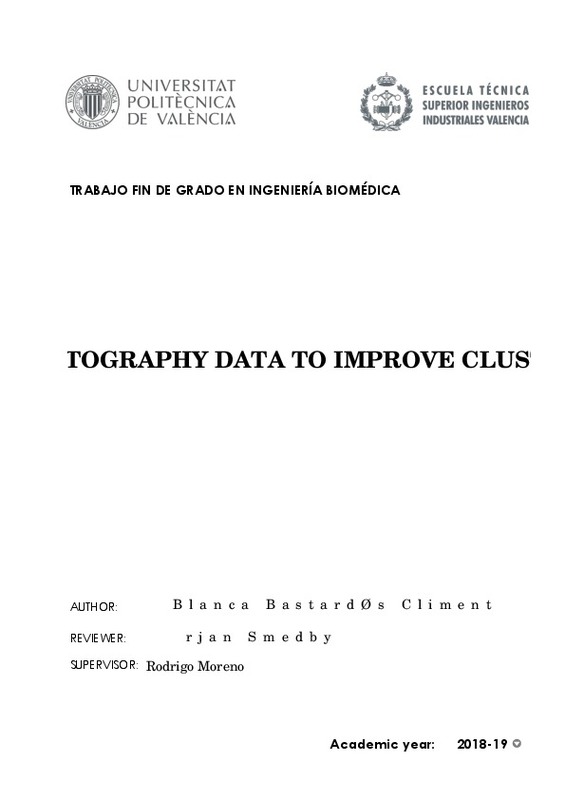|
Resumen:
|
[ES] Muchas patologías neurodegenerativas del cerebro están estrechamente relacionadas con la degeneración de la materia blanca, lo que desarrolla alteraciones en la difusión de agua en el tejido. Por este motivo, es ...[+]
[ES] Muchas patologías neurodegenerativas del cerebro están estrechamente relacionadas con la degeneración de la materia blanca, lo que desarrolla alteraciones en la difusión de agua en el tejido. Por este motivo, es esencial estudiar las conexiones neuronales para mejorar el diagnóstico y el tratamiento de las enfermedades cerebrales. La tractografía es una técnica no invasiva que permite la visualización de tractos de materia blanca in vivo a partir de Imágenes de Resonancia Magnética de difusión (dMRI). Sin embargo, hay mucha variabilidad entre resultados debido a la falta de una metodología estandarizada o procedimientos automáticos a seguir. El objetivo de este proyecto es establecer un procedimiento con métodos probabilísticos específicos para realizar una estimación óptima de las orientaciones de las fibras de la materia blanca dentro de cada vóxel, incluso en regiones confusas donde hay presentes cruces de fibras. Este procedimiento se utilizará para crear un conjunto de datos que se emplearán en el futuro para generar atlas poblacionales, que no solo serán clínicamente útiles para evaluar posibles alteraciones anatómicas en el cerebro, sino también para el refinamiento de los resultados de la tractografía. La tractografía se realizó utilizando Imágenes de Difusión de Alta Resolución Angular (HARDI) de sujetos sanos. El número de tractos seleccionados para generar el tractograma fue de 10 millones. Las características geométricas se extrajeron para cada vóxel de tres regiones diferentes de todo el tractograma. La ubicación de las regiones se decidió en función del número de fibras presentes. Esta información fue extraída de la literatura. Por otra parte, también se generaron tractogramas de 500.000 y 1.000.000 tractos. Se aplicó el método de Spherical-Deconvolution Informed Filtering of Tractograms 2 (SIFT2) a los tres tractogramas y se evaluó su contribución, pero apenas alteró los resultados. También se exploró la relevancia del número de líneas a generar. 1.000.000 líneas resultó ser un número suficiente. Finalmente, se utilizaron dos métodos de clustering diferentes para distinguir los diferentes haces de fibras presentes en cada vóxel, utilizando las características anteriores. Uno de los métodos de agrupamiento explorado fue el método Mean Shift, que resulta ser prometedor. Sin embargo, para refinar la precisión de los resultados, se debe adaptar la medición de la distancia y considerar un mayor número de parámetros, como la curvatura.
[-]
[EN] Many neurodegenerative brain pathologies are closely tied to white matter degeneration which develops alterations in water diffusion at the tissue. For this reason, it becomes essential to study the neural connections ...[+]
[EN] Many neurodegenerative brain pathologies are closely tied to white matter degeneration which develops alterations in water diffusion at the tissue. For this reason, it becomes essential to study the neural connections in order to improve diagnosis and treatment of brain diseases. Tractography is a non-invasive technique that allows the visualization of white matter tracts in-vivo from diffusion Magnetic Resonance Imaging (dMRI). However, there are many differences between results due to the lack of a standardized methodology or automatic procedures to follow. The aim of this project is to set a procedure with specific probabilistic methods to perform an optimal estimation of white matter fiber orientations within each voxel, even at confusing regions where crossing fibers are present. This procedure will be used to create a dataset that will be used in the future to generate population atlases, which will be not only clinically helpful to evaluate possible anatomical alterations in the brain but also in refinement of tractography results. The tractography was performed using High Angular Resolution Diffusion Imaging (HARDI) of healthy subjects. The number of tracts selected to generate the tractogram was 10 million. Geometrical features were extracted for each voxel from three different regions of the whole tractogram. The location of the regions was decided based on the number of fibers present. This information was extracted from literature. Moreover, tractograms of 500.000 and 1.000.000 tracts were also generated. The method Spherical-Deconvolution Informed Filtering of Tractograms 2 (SIFT2) was applied to the three tractograms and its contribution was tested, but it barely changed the results. The relevance of the number of streamlines was also explored. 1.000.000 streamlines were found to be a sufficient number. Finally, two different clustering methods were performed to distinguish the different fiber bundles present in each voxel, using the previous features. One of the clustering methods explored was the Mean Shift method which seems to be promising. However, to refine the accuracy of the results, distance measurement should be adapted, and a greater number of parameters considered, such as curvature.
[-]
|







